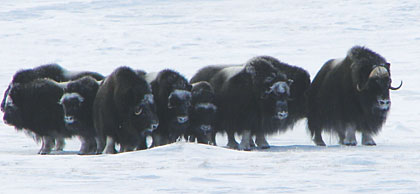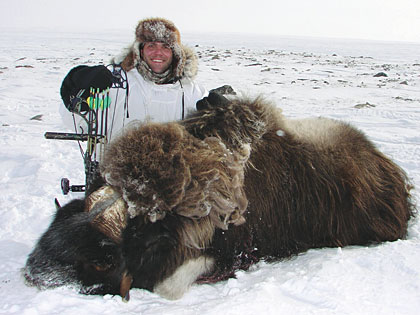November 04, 2010
By Dr. Eyad H. Yehyawi
By Dr. Eyad H. Yehyawi

Advertisement
When surprised, musk oxen may flee, but more often they will form a protective circle with young in the center and more mature animals to the outside. |
Advertisement
DRIVING DOWN THE INTERSTATE, I couldn't help but smile as the voice on the radio said, "Today's high will be — 40 with the windchill. The National Weather Service has issued a winter storm warning advising you to stay indoors."
While most people would dread that report, I had been craving it. After all, in Iowa, — 40 degrees F. windchill is not common.
Am I crazy? No. I was hoping for weather like this to prepare me for an environment where I would soon be headed, a location 300 miles north of the Arctic Circle, the home of an animal the Inuits call umingmak, meaning "the bearded one," or "the animal with skin like a beard" -- in short, the musk ox.
Living north of the Artic Circle, musk oxen are built to withstand high winds and winter temperatures as cold as — 50 F. And, of course, musk ox hunters must survive the same bitter conditions. That's why I was so excited about that frigid day in Iowa. It would give me a stage for a dress rehearsal.
Above all, I knew that leaving any skin exposed could lead to severe frostbite and even the loss of fingers or toes, so I covered every inch of my face and eyes. A neck gaiter, ski goggles, full facemask, and large mittens over thin gloves seemed to ensure good protection. Over my body I wore a combination of layers that would allow me to move freely while keeping me warm. I chose boots constructed of 2,000-gram Thinsulate Insulation. Perhaps most importantly, I protected my head with a beaver fur hat a friend had loaned me. Bundled in all this carefully chosen gear, I went out to practice with my bow in the — 40 Iowa weather. I felt more like the Stay Puft Marshmallow Man than a bowhunter!
In researching where to go, I decided on Cambridge Bay on Victoria Island, the second largest island in Canada that supports a thriving herd of musk oxen. Initially, I almost booked in August, when the weather is pleasant and bowhunters stalk individual bulls on the rolling tundra.
However, every time I thought of this option, the excitement left me, making me realize I had to do this the right way at the right time. On most hunts, the experience rather than the harvest forges the most lasting memories, and my heart told me my Arctic memories must include bitter cold, a bit of apprehension, and an appreciation for the harsh environment these animals -- and the native hunters -- withstand most of the year.

When traveling in wooden sleds across the frozen tundra, you must cover every inch of your face, body, and eyes to prevent frostbite. Jolting across the ice in this contraption was like getting hit by Ivan Drago. |
ON MARCH 28, I flew from Cedar Rapids, Iowa, to Edmonton, Alberta, and then to Yellowknife, Northwest Territories, where I spent the night. My flight to Cambridge Bay, Victoria Island, left at dawn, but as we approached the small Arctic town, the captain reported that a severe blizzard would prevent our landing. Further, instead of returning straight to Yellowknife, we would embark on a "milk run" to deliver supplies to other communities. Other hunters on board were disappointed, but I was excited for the experience. Over the next 10 hours we landed in Gjoa Haven on King William Island, Pelly Bay, and finally Taloyoak on the Boothia Peninsula, where I talked with many locals about polar bears, Arctic char, and endless winters.
Weather kept us in Yellowknife the next day, but, finally, on March 31, under blue skies and frigid temperatures, we made our way to Cambridge Bay. As we looked down on a sea of white, I could almost feel the brutal cold awaiting me. All the traveling over the past four days had left me drowsy, but the surge of bitter air that hit me when we stepped off the plane woke me faster than a shot of Red Bull. I thought riding my ATV in a thin jacket and shooting my bow in sub-zero weather would prepare me, but nothing could have fully prepared me for this.
That night we stayed in Cambridge Bay, and the morning of April 1, we loaded sleds and departed across the frozen tundra. While the cold was bad, the long journey in wooden sleds behind snowmobiles trumped even that. Every crevice, rock, and hump in the ice jolted my system. Now I knew what Rocky Balboa felt like as he battled the mighty Russian Ivan Drago. The anticipation of the next shot was almost worse than the former, but after some distance I grew accustomed to the back-pounding ride.
The plan was to travel to vantage points and to glass the endless landscape of snow and ice for herds of musk oxen. With a herd located, I would pursue on foot to get within bow range. That was the plan anyway.
Musk oxen are very protective and, when threatened, will form a circle with young ones in the center and mature animals on the outside, which can make for a tough shot. Above all, you have to wait for the bull you want to become isolated to avoid hitting a second animal.
After a couple hours of looking through binoculars, we found a group that appeared to host a few good bulls, and quickly I evaluated my equipment, making sure that my release wasn't frozen, my armguard would keep my coat sleeve out of the bowstring, and my broadheads and my PSE X-Force were in good condition after the rough sled ride.
As I began my slow approach on foot toward the herd, the wind slammed me in the face like another blow from Ivan Drago. Wow, was it cold! Fortunately, the adrenaline surging through my veins mitigated the effects a little as I intently focused on the bulls ahead of me. At a distance of 100 yards, three bulls became agitated and actually started walking toward me. This made me a bit uneasy, but I put my head down into the wind and continued my march. To prepare for a shot, I removed my mittens, leaving only my thin gloves between my bare palms and the bow handle. Those gloves tried their best to protect me from the cold, but my fingers went numb within minutes.

Kneeling beside the majestic musk ox bull was a humbling experience, as these animals possessed a strength and endurance I had never witnessed before. |
The tension increased as the three bulls lined up and glared at me, seemingly daring me to come closer. At 50 y
ards, their patience seemed to be wearing thin, and they all began to rub their noses and eyes on their front legs. Then they all raised their horns and faced me head on.
As I closed the gap to 40 yards, the other two bulls seemed to vanish as I focused on the one before me with worn bosses and long hair whipping in the arctic wind. Whether my heavy breathing was due to the adrenaline rush or the frigid air, I do not know.
At 28 yards, the bull I was focused on started to rub his nose on his front legs and move toward me again. I forgot to mention the most important piece of advice given to me by those who had hunted musk oxen: If a bull starts to rub his nose on his front legs, the gig is up, and he is about to charge. Quickly I took one step back, which seemed to ease his disposition a little.
The rest happened very fast. When the bull started to turn and angle away, my instincts took over, and I released an arrow into the quartering-away bull. He seemed unfazed, and I began to question my shot placement. Then he stumbled and was down within seconds.
ARRIVING BACK IN CAMBRIDGE BAY with the caped and quartered bull, we learned that the Nunavut Day celebration was taking place that night at the community center. The territory of Nunavut was established on April 1, 1999, and this was the 10th anniversary. The other hunters and I were humbled and excited that the locals would invite us to their celebration.
It was a night I will never forget, as we witnessed various Inuit traditions such as throat singing, dancing, and the high kick, as well as many Inuit foods. Many of the elders were preparing narwhal, caribou, musk ox, and Arctic char. All night I visited with the locals, sharing hunting stories, laughing, eating, and feeling very fortunate to experience this evening in the Arctic.
As is true for all species, hunting the musk ox is about the adventure, the challenge, and the memories. I have never felt as humbled as I did facing umingmak that frigid Arctic day. Humility is a precious emotion, and bowhunting ensures that my glass is always half full. Victoria Island, the Inuit culture, sled rides over frozen lakes and tundra, the stark and simple Arctic beauty, a bitter cold that is unlike anything I have ever experienced, and bearded beasts that survived the Ice Age and continue to thrive in that environment today make a journey to this northern destination not an adventure, but a very memorable expedition!
The author is an optometrist from Cedar Rapids, Iowa.
Author's Notes: I used a PSE X-Force at 70 lbs, Carbon Express Aramid KV arrows, 125-grain Slick Trick Magnum broadheads, Whisker Biscuit rest, and Scott release. To book a great musk ox hunt, contact: Mark Buehrer, Bowhunting Safari Consultants, (419) 943-3743; (419) 890-7199 (cell); bohuntrm@watchtv.net; www.bowhuntingsafari.com

